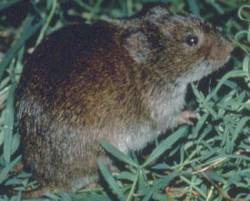Field Guide/Mammals/Meadow Vole
< Field Guide | Mammals
| Microtus pennsylvanicus (Meadow Vole) | |
|---|---|
|
Family: Cricetidae
Size: Weighing on average 1.5 oz (48 g) the Meadow Vole is a small rodent that is around 5 to 7 inches long (128 to 195 mm) with a tail that is over 40% of their body size.[1]
Description: The back of the meadow vole is very dark brown and black colored with very coarse hairs. Their stomachs are a very light tan, white, or light brown color.[1]
Similar Species: Similar species to the Meadow Vole are Pine Voles and other types of voles. Their skulls are rather long and slightly angular making them different from other species. Also, the meadow vole is larger than the pine and other voles and also have longer tails. Voles are very good swimmers that can dig very well too.[1]
Range: Home to central North America, it is the largest mole population across the nation. The Meadow vole makes his home all the way across the country including Alaska and a small part of southern Canada.[1]
Habitat: Because the Meadow Vole is a good swimmer, you can find this species along rivers and lakes, grassy marshes and lowland fields. Meadow Voles can also be found in some fields but are mainly in meadows and wet areas. Flooded marshes and grasslands are another habitat these creatures can be seen.[1][2]
Diet: Not only are grasslands commonly the home for the Meadow Vole, fresh grass is often consumed by this critter as well. Besides grass, they tend to eat seeds, grains, sedges, herbs. Their vegetation changes with the season eating more grass in the summer and more grains in the winter. A vole will eat 60% of its body weight at a time.[1]
Activity: The Meadow Vole is nocturnal during the summer and winter months but is active all times of day during spring and fall. Females are very territorial and the only time that you will see two females together are if they are mother and daughter. Males will live a range of areas.[1]
Reproduction: Females may bare babies during any month of the year but most are born in spring and fall. Voles grow quickly, weaning off of their mothers in around 12 days after birth. Females can breed when they are only 28 days old but males are not ready until around day 35. On average, about five voles are born at a time.[1][2]
Lifespan: Live usually less than a year due to predators but can live up to around two years.[1]
Notes: When it comes to breeding, the mothers are very territorial. It has been observed that the meadow vole females to not like to let their young breed although they are mature enough to. The reason behind this is unknown. Also, they hardly make noise but when they do, they are using their vocals in a defensive situation not and offensive. They can also hear and smell really well which helps them out in the wild. Although they are small, meadow voles are small, they are very aggressive and will attack.[1]
|
 |